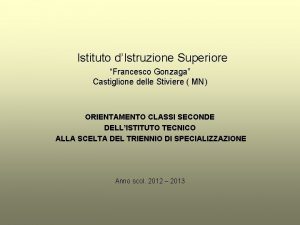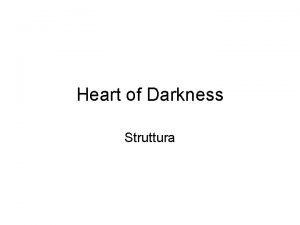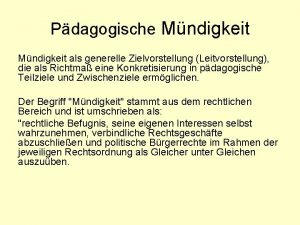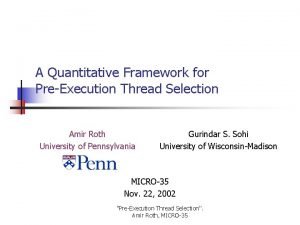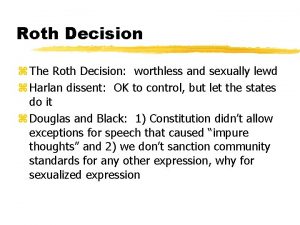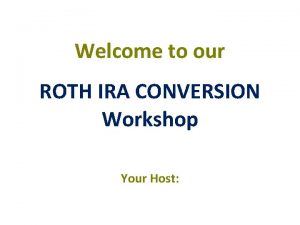Roth IRA vs Traditional IRA Vicente J Gonzaga





























- Slides: 29

Roth IRA vs. Traditional IRA Vicente J. Gonzaga Erl Malboeuf Team 6

Overview �What are IRAs? �Roth vs. Traditional �The Scenario �Analyses and Comparisons �Conclusions

What are IRAs? �IRA = Investment Retirement Account Specialized savings accounts specifically geared for post-retirement funding �Tax features Tax-deductible Tax-deferred Tax -free

Choices, Choices �So why are we up here? �IRAs come in two main flavors: 1) Traditional 2) Roth �Which one?

Roth vs. Traditional �Traditional IRA Contributions are tax-deductible ▪ $75, 000 gross salary ▪ Deposit 10% ($7, 500) into a Traditional ▪ ($75, 000 -$7, 500)=$67, 500 (new gross income) �Cool beans, right?

Traditional IRA �Contributions are tax-deductible, but withdrawals are taxed based on the income bracket they fall under �Traditional IRAs Tax-deductible contributions Tax-deferred balance growth Taxed withdrawals/distributions

Roth IRA �Roth IRA Contributions are not tax deductible ▪ $75, 000 gross salary ▪ $75, 000 – [25%($75, 000)]=$56, 250 ▪ THEN deposit 10% ($5, 625) into the Roth IRA ▪ $5, 625<$7500 (from Traditional) �Ew… right?

Roth IRA �Contributions are made with after-tax dollars, but withdrawals are tax-free. �Roth IRA Contributions based on after-tax dollars Balance growth is tax-free Withdrawals/distributions are tax-free

Roth and Traditional �Important fact to keep in mind: Both Roth and Traditional IRAs impose contribution caps (equal for both) ▪ Caps are adjusted for inflation every few years. ▪ For simplicity, we treated cap adjustment as continuous These caps greatly affect the dynamics of the savings plan given initial conditions.

The Pitch �You are Yoda (you can live for a very, very long time). �You have used the force to earn an engineering degree and have landed a position with $60, 000 gross annual pay “Long, I live. ”

Major Assumptions �Deposits will always be a fixed percentage of available income �“Excess” savings (explained later) will go into market investment We later neglect “excess” �Assume no pension �Tax brackets always apply where appropriate

Default Values �Starting Gross Salary: $60, 000 �Expected Annual Raise=8% �Annual deposit rate: 10% Applies to available income Deposits between accounts are not equal This is strictly followed �Post-retirement Lifestyle: $65, 000 �Total years employed: 41

Default Values �Inflation: 3. 5% �IRA Caps increase by inflation (=3. 5%) �Interest earned on both IRAs: 5% �Market ROR: 9. 00% �Retirement Assets ROR: 6. 00%

The Reference Parameter? �Debt-free years after retirement! �How long under each account given equal conditions will you last after retirement?

Our Goal �UNPRECEDENTED , NEEDLESSLY METICULOUSL ACCURACY �(Flip to excel file and previous presentation on similar topic)

Assumptions Made (from a past class’ presentation) � Equal contributions to both plans � Roth IRA ineligibility ignored � Flat tax (not tiered) � Annual salary raises kept up with inflation at 3% � ROR is 10% � No 401 K matching from employer � No Social Security Benefits � No investment fees � 35 working years

Excess Included 200. 00 Years vs. EAR 180. 00 12. 0%, 175. 00 160. 00 140. 00 Years 120. 00 100. 00 Roth Traditional 80. 00 12. 0%, 73. 15 60. 00 40. 00 20. 00 0. 0% 2. 0% 4. 0% 6. 0% EAR 8. 0% 10. 0% 12. 0% 14. 0%

Excess Included 70. 00 Years vs. Deposit Rate 60. 00 50. 00 Years 40. 00 Roth Traditional 30. 00 20. 00 10. 00 0% 2% 4% 6% 8% Deposit Rate 10% 12% 14% 16%

Excess Included 70 Years vs. Salary 60 50 Years 40 Roth Traditional 30 20 10 0 0. 00 20000. 00 40000. 00 60000. 00 Starting Salary 80000. 00 100000. 00 120000. 00

Excess Included 30. 00 Years vs. Employed Years 25. 00 Years 20. 00 15. 00 Roth Traditional 10. 00 5. 00 0 5 10 15 20 25 Employed Years 30 35 40 45

So Far… �It looks like Traditional IRA is the better choice�But is the whole story? Remember that we’ve been including excess savings (that have been invested with an ROR of 9. 00%) �Let us now neglect excess savings

Excess Is Neglected! 6. 00 Years vs. EAR 5. 00 Years 4. 00 3. 00 Roth Traditional 2. 00 1. 00 0. 0% 2. 0% 4. 0% 6. 0% EAR 8. 0% 10. 0% 12. 0% 14. 0%

Excess Is Neglected! 6. 00 Years vs. Deposit Rate 5. 00 Years 4. 00 3. 00 Roth Traditional 2. 00 1. 00 0% 2% 4% 6% 8% Deposit Rate 10% 12% 14% 16%

Excess Is Neglected! 6 Years vs. Starting Salary 5 Years 4 3 Roth Traditional 2 1 0 0. 00 20000. 00 40000. 00 60000. 00 Starting Salary 80000. 00 100000. 00 120000. 00

Excess Is Neglected! 6. 00 Years vs. Years Employed 5. 00 Years 4. 00 3. 00 2. 00 1. 00 0 5 10 15 20 25 Years Employed 30 35 40 45

The Tables have Turned! �So what just happened? Excess Included => IRA wins Excess neglected => Roth wins �Which one really wins? The answer lies in the circumstances, and may change according to certain factors blahblah…

BASICALLY �It depends! �Traditional IRA “won” with excess This implies that the Traditional IRA allows for more flexibility with extra savings! �Roth IRA “won” when excess was neglected This implies that between the two, Roth IRA has the longest staying power based purely on account withdrawals!

The Bottom Line �The Roth IRA is the safer option for people who choose to invest extra savings minimally. If left to account balance alone, the Roth will outlast the Traditional. �People who tend to rely on earned interest and surefire, small investments should choose the Roth.

The Other Bottom Line �The Traditional IRA allows for creative use of large excess savings but does not have as much post-retirement staying power as the Roth. It is therefore slightly riskier. �People who are more confident investors and are investment-savvy may benefit more from a Traditional IRA, or may find the Traditional more appealing.
 Tim roth ernie roth
Tim roth ernie roth Vicente gonzaga
Vicente gonzaga Backdoor roth ira conversion white coat investor
Backdoor roth ira conversion white coat investor Roth ira hamilton
Roth ira hamilton Primerica ira roth
Primerica ira roth Gil vicente vida e obra
Gil vicente vida e obra Istituto statale francesco gonzaga
Istituto statale francesco gonzaga Gonzaga course selection
Gonzaga course selection Gonzaga course catalog
Gonzaga course catalog Músicas de luiz gonzaga
Músicas de luiz gonzaga Assum preto luiz gonzaga
Assum preto luiz gonzaga Giovanni de medici
Giovanni de medici 6151 san luis gonzaga
6151 san luis gonzaga The metamorphosis movie 1987
The metamorphosis movie 1987 Segno di tinel tunnel tarsale
Segno di tinel tunnel tarsale Polyzentrischer ansatz
Polyzentrischer ansatz Nm interlock indigent fund
Nm interlock indigent fund Tim roth heart of darkness
Tim roth heart of darkness Artikulationsschema roth
Artikulationsschema roth Marija roth psiholog
Marija roth psiholog Neuron yale tutorial
Neuron yale tutorial Pädagogische leitvorstellungen beispiele
Pädagogische leitvorstellungen beispiele Roth robertson
Roth robertson Stefan roth rwth
Stefan roth rwth Eli, the fanatic summary
Eli, the fanatic summary Lesezentrum gehirn
Lesezentrum gehirn John reece roth
John reece roth Keely roth
Keely roth Cis 419 upenn
Cis 419 upenn Amir roth
Amir roth






